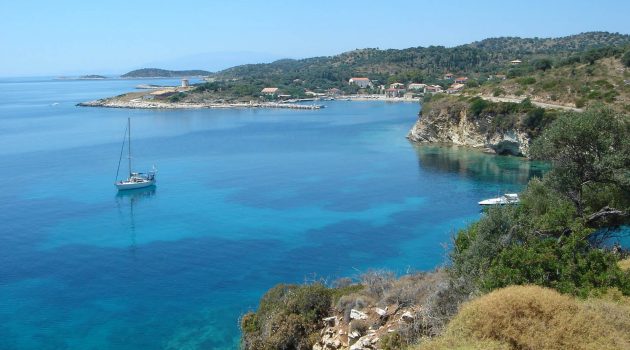Kalamos
Kalamos is an island southeast of Meganisi, near the village of Mytikas of Aetoloacarnania, from where you can access it by sea. It is mountainous, green (with a pine forest that you can also see on the islands of Sporades within Greece) and with mostly rocky coasts.
There are three harbouring places, the port of Kalamos, the port of Episkopi and the haven of Porto Leone on the south-eastern side, where there is also a bridge that is about two centuries old.
There two main settlements on the island, Kalamos and Episkopi. There are also the remains of a third settlement at Kefali, and two smaller ones, that is Kastro and Agrapidia. Most of its people are mariners while some of them deal with fishing, olive cultivation and animal breading.
The island has beautiful pebbly beaches with some of them beuing accessible only by sea, such as Myrtia and Asprogyali near the port, Agrapidia, Pefki and Kefali further to the south, Kedros, Alexaki, Kipi and Trahilos on the west side.
The windmills as well as the caverns in Agrapidia are particularly interesting.
Near Episkipi Kastromonastiro (Castle-Monastery) is worth visiting, of which only remains of its walls are still preserved. This is allegedly the burial place of the mother of Georgios Karaiskakis, the great warlord of the Greek Revolution, because his family found shelter on the island during the revolution.
At the beautiful beach of Agios Konstantinos there is a small stone private chapel dedicated to Agios Donatos and there is also the half-ruined, unfortunately, church of Agios Ioannis, where there is a plaque with the year 1648 on it, maybe the year of the church’s construction.
Historians claim that the island was populated for the first time in the end of the 14th century. In 1810 it hosted the warlord Theodoros Kolokotronis, before he arrived in Lefkada, where, with the help of the English, he got rid of the French. Furthermore, Kalamos had been a refuge for thousands of women and children during the years of the Greek Revolution.
Kastos
Kastos is a small island southeast of Lefkada, very close to Mytikas of Aetoacarnania, the port from which you can access the island.
The single settlement of the island is located on the east side and has stone houses and small taverns around the port. It is a green clad island with many olive trees and vineyards. On the east coast there are beautiful beaches such as Ampelakia, Vali, Kilada, Limni, Kamini, Vrisidi and Agios Emilianos, where Fokotrypa (Seal Hole) is located, a small cave with a beach inside it. On the south side there is the beach Fyki.
Its west coast is very steep and only the bay of Sarakiniko, with a small pier, can be used as a shelter for boats.
The main products of the island are cereals, grapes and wine.
Although Kastos is a rather small island it has interesting sites such as the temple of Agios Ioannis Prodromos, which was built in the 19th century, with oil paintings of Spyridon Gazis, the chapel of Agios Emilianos and the olive grove with century old olive trees in Kalikerimi. Furthermore, there are old olive mills and many windmills on the island. One of the windmills is the best preserved in the Ionian Islands with all its apparatuses intact. It had been functioning until 1949.
Archaeological findings from the Post-Hellenistic, Roman and Early Byzantine years have been disoverd on the islnd. Like Kalamos, Kastos was also a refuge for both fighters and civilians during the Greek Revolution.
Via Go Lefkas

